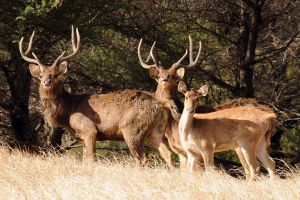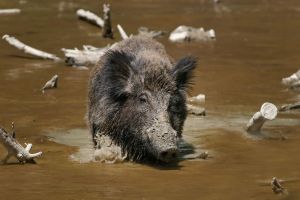Australia
In Australia you can hunt for water buffalo, banteng and big wild boar in the wilds of the outback

Highligts
- Special Game Species
- Extraordinary Nature
- Huge, Aggressive Boars
- Large Stocks of Water Buffalo
Hunting in Australia
In Australia’s Northern Territory you can realise your dreams of a grand wildlife adventure, rich in contrasts. In this region you can find tropical rainforests, mountains and fascinating rock formations, open savannah, mangrove filled lagoons and idyllic lakes. Very few people live here, which is one of the factors that help to create an optimal habitat for a rich diversity of wildlife. It is also possible to find rock paintings, created thousands of years ago by Australia’s original inhabitants, the Aborigines.
In Australia’s Northern Territory you can really live your dream of a huge wildlife experience rich in contrasts. This state offers tropical rainforest, mountains and huge rock formations, open savannah, mangrove filled lagoons and idyllic lakes. Few people live here, and this is one of the reasons the region offer optimal conditions for a wealth of animal life. Here you can also find impressive rock paintings, created thousands of years ago by Australia’s original inhabitants, the Aborigines.
It is only here that you can hunt Asian water buffalo, with their huge trophy, in the open countryside. It is a very much sought after trophy amongst big game hunters. A bull buffalo weighs between 700-1000 kg and buffalo experts rate them as no less exciting to hunt as the African Cape Buffalo. In addition to the water buffalo there is a good population of big wild goats, and in the far-flung, uninhabited parts of the region, enormous numbers of wild boar have grown up over the years. Finally we can also offer hunting for banteng and sambar deer.
Video Gallery

-
 Buffalo Hunt in Australia - Hunters Video
Buffalo Hunt in Australia - Hunters Video
Game

Axis Deer
Videnskabeligt navn: Axis axis Underarter: Ingen Udbredelse: Indien, Srilanka (Ceylon), sydlige Nepal I 1813 og 1866 indført til Queensland og Victoria (Australien) fra Indien, samt i 1908 indført til den sydlige ø på New Zealand. Ligeledes indført i Argentina, Brasilien, Uruguay, Hawaii, Texas, Californien (USA), samt i det daværende...
Read more
Banteng
Scientific Name: Bos javanicus Subspecies: 1. Bos j. birmanicus: Eastern Assam, Bangladesh, Myanmar, Thailand, Laos, Kampuchea, Vietnam and Malaysia. 2. Bos j. javanicus: Java, Bali. Introduced into northern Australia. 3. Bos j. Iowi: Borneo. Habitat: Wet and dry deciduous forest, swamps and rainforest. Description: Large buffalo weighing up to 800 kg and measuring up to 1,80 m over the...
Read more
Blackbuck Antelope (Oceanien)
Videnskabeligt navn: Antilope cervicapra Udbredelse: De er hjemmehørende i Indiens og Pakistans sletter og de blev introduceret flere steder i Australien og Argentina i begyndelsen af 1900-tallet. Beskrivelse: Blackbuck er en yndefuld og smuk antilope med kontrasterende mørk-hvid farve. De vejer mellem 35-50 kg.
Read more
Fallow Deer (Oceania)
Scientific Name: Cervus dama Subspecies: None. Distribution: Introduced into New Zealand from England between 1864 and 1900. In 1850 they were introduced into Australia on Tasmania, in Queensland, New South Wales and Gippsland. Habitat: Prefers park-like areas, but is also found in forests and on farmland. Description: Medium sized deer weighing up to 200 kg and measuring up to 1,40 m over...
Read more
Hog Deer
Videnskabeligt navn: Axis porcinus Udbredelse: Australien og Asien Beskrivelse: Hjorten er den mindste hjort i Australien og er meget sjælden. De vejer mellem 36-45 kg.
Read more
Moluccan Rusa Deer
Videnskabeligt navn: Rusa timorensis moluccensis Udbredelse: Australien Beskrivelse: Det er den sjældnere af de to Rusa og kan kun jages i Australien. Som det videnskabelige navn antyder, er det en nær slægtning til Javan-rusaen. Den vejer mellem 63-93 kg.
Read more
Red Deer/Red Stag (Oceania)
Scientific Name: Cervus elaphus Subspecies: Can not be recontructed. Distribution: Was introduced into New Zealand in 1851 (possibly from Scotland). Habitat: Mountain forests and open areas. Also farmed. Description: Large deer weighing more than 200 kg and measuring up to 1,50 m over the shoulder. General colour rufous brown in summer and grey to greyish brown in winter. The antlers...
Read more
Rusa Deer
Videnskabeligt navn: Cervus timorensis Underarter: 6 Underarter: 1. Cervus t. timorensis: Timor . 2. Cervus t. moluccensis: Molukkerne. 3. Cervust. macassaricus: Celebes og omkringliggende øer. 4. Cervus t. djonga: Muna- og Buron-øerne. 5. Cervust. floresiensis: Flores, Lombok, Komodo og omkringliggende øer. 6. Cervus t. russa: Java, Bali, (indført fra...
Read more
Sambar (Oceania)
Scientific Name: Cervus unicolor Subspecies: 8 subspecies have been described, 7 of which occur in the Indo-pacific region: 1. Cervus u. unicolor: Sri Lanka. 2. Cervus u. niger: India and Bangladesh. 3. Cervus u. cambojensis: Southern China, Myanmar, Laos, Kampuchea, Vietnam and Thailand. 4. Cervus u. equinus: Malaysia, Sumatra, central part of southern China (Sichuan, Hubei and Hunan). 5....
Read more
Wild Boar (Oceania)
Scientific Name: Sus scrofa Subspecies: 17 in total, 7 of which occuring in the Indo-pacific region: 1. Sus s. jubatus: Malaysia. 2. Sus s. cristatus: Pakistan, India, Nepal, Bhutan, Myanmar, Thailand, Laos, Kampuchea, Vietnam and Sri Lanka. 3. Sus s. andamanensis: The Andaman Islands. 4. Sus s. nicobarus: The Nicobar Islands. 5. Sus s. vittatus: Sumatra, Java, Bali, Lombok, Banka and Sumbava....
Read more
Wild Water Buffalo (Oceania)
Videnskabeligt navn: Bubalus arnee Underarter: 4 Underarter: 1. Bubalus a. arnee: Indien, indført til Sri Lanka og Tunesien. 2. Bubalus a. fulvus: Nordassam (Indien). 3. Bubalus a. bubalis: Thailand, Laos, Cambodja, Vietnam, Malaysia. 4. Bubalus a. hosei: Borneo. Er derudover indført til Nordaustralien, Brasilien og Argentina. Levested: Sumpe, græsrige urskove, marskland,...
Read moreHunting Area

Arnhemland
Arnhemland, where the hunt takes place, covers 100,000 km2, which is more than twice the size of Denmark. It is possible to choose between 2 modes of transport to get to the hunting district. The most comfortable is clearly chartering an aircraft to fly from Darwin to Bulman, an aboriginal town in the heart of Arnhemland. The flight takes 1.5 hours, and is followed by a car journey of around 1-2...
Read more
Kingham
The hunting area Kingham is an 8,000-hectare cattle farm, of which approx. 2,500 hectares are fenced and are situated in beautiful surroundings in the mountains outside the city of Brisbane at an altitude of 600 metres. The area is surrounded by approx. 40,000 hectares of national forest, which is why only very few people live in the area and hunting pressure is very minimal. On the hunt you can...
Read morePartner

Australian Buffalo Hunters
Our partners here are Australian Buffalo Hunters, who are owned by Graham Williams. He has hunted and arranged hunting in Arnhemland since the late 90’s which makes Australian Buffalo Hunters are one of very biggest names in the business when it comes to hunting water buffalo. In the hunting district their focus is very much on game management, which over the years has helped sec ure...
Read more










